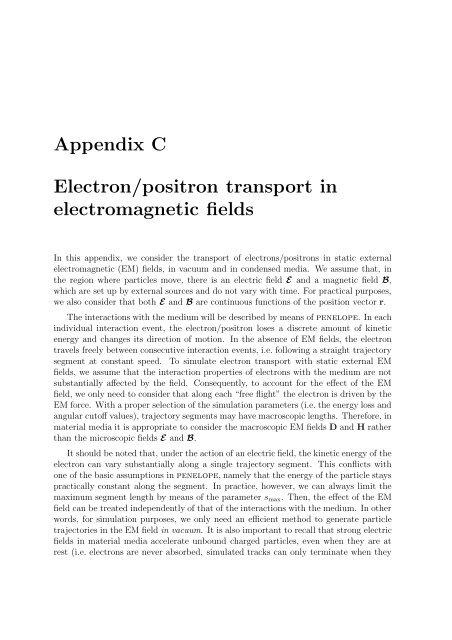PENELOPE 2003 - OECD Nuclear Energy Agency
PENELOPE 2003 - OECD Nuclear Energy Agency
PENELOPE 2003 - OECD Nuclear Energy Agency
Create successful ePaper yourself
Turn your PDF publications into a flip-book with our unique Google optimized e-Paper software.
Appendix C<br />
Electron/positron transport in<br />
electromagnetic fields<br />
In this appendix, we consider the transport of electrons/positrons in static external<br />
electromagnetic (EM) fields, in vacuum and in condensed media. We assume that, in<br />
the region where particles move, there is an electric field E and a magnetic field B,<br />
which are set up by external sources and do not vary with time. For practical purposes,<br />
we also consider that both E and B are continuous functions of the position vector r.<br />
The interactions with the medium will be described by means of penelope. In each<br />
individual interaction event, the electron/positron loses a discrete amount of kinetic<br />
energy and changes its direction of motion. In the absence of EM fields, the electron<br />
travels freely between consecutive interaction events, i.e. following a straight trajectory<br />
segment at constant speed. To simulate electron transport with static external EM<br />
fields, we assume that the interaction properties of electrons with the medium are not<br />
substantially affected by the field. Consequently, to account for the effect of the EM<br />
field, we only need to consider that along each “free flight” the electron is driven by the<br />
EM force. With a proper selection of the simulation parameters (i.e. the energy loss and<br />
angular cutoff values), trajectory segments may have macroscopic lengths. Therefore, in<br />
material media it is appropriate to consider the macroscopic EM fields D and H rather<br />
than the microscopic fields E and B.<br />
It should be noted that, under the action of an electric field, the kinetic energy of the<br />
electron can vary substantially along a single trajectory segment. This conflicts with<br />
one of the basic assumptions in penelope, namely that the energy of the particle stays<br />
practically constant along the segment. In practice, however, we can always limit the<br />
maximum segment length by means of the parameter s max . Then, the effect of the EM<br />
field can be treated independently of that of the interactions with the medium. In other<br />
words, for simulation purposes, we only need an efficient method to generate particle<br />
trajectories in the EM field in vacuum. It is also important to recall that strong electric<br />
fields in material media accelerate unbound charged particles, even when they are at<br />
rest (i.e. electrons are never absorbed, simulated tracks can only terminate when they
















